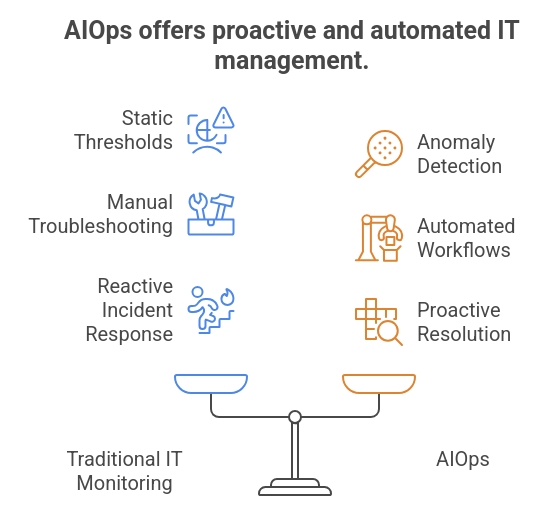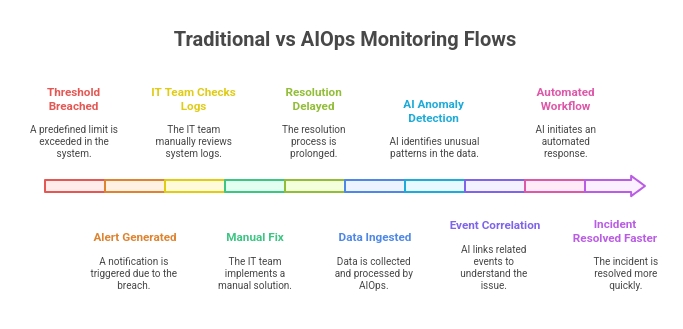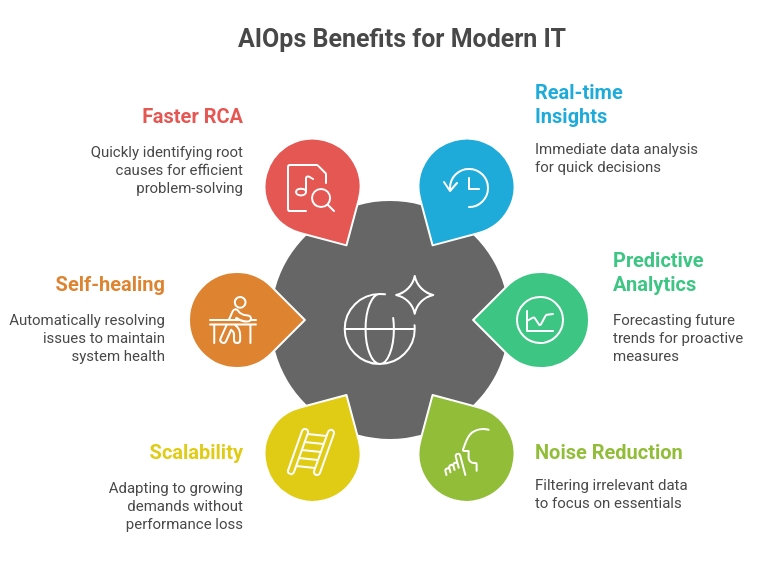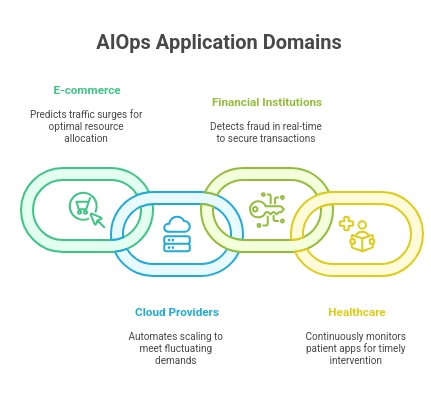Explore AIOps vs Traditional IT Monitoring. Learn how enterprises can improve reliability, speed, and efficiency by shifting to intelligent operations. Our AIOps Support Team is always here to help you.
AIOps Vs Traditional IT Monitoring: Which One Should Modern Enterprises Choose?
IT teams have always relied on monitoring tools to keep systems healthy and minimize downtime. For decades, Traditional IT Monitoring did the job well enough, tracking server health, flagging errors, and alerting teams when performance dipped below a fixed threshold. But as businesses scaled into cloud, hybrid, and microservices environments, these rule-based tools started showing their age.
Enter AIOps, a data-driven approach that uses advanced analytics and automation to transform IT operations. Businesses today are asking a crucial question: AIOps vs Traditional IT Monitoring, what works better for modern infrastructure?
Let’s break this down with a clear-eyed comparison, practical insights, and real-world use cases.
An Overview
What is Traditional IT Monitoring?
Traditional IT monitoring has been the backbone of IT operations for decades. At its core, it relies on manual processes and pre-set rules. IT teams configure thresholds, for example, CPU usage exceeding 90%, and the system generates alerts once those limits are breached.
Main traits of Traditional IT Monitoring:
- Rule-based alerts: Triggered by predefined thresholds.
- Manual setup: Teams configure every system and log source individually.
- Data collection without correlation: Limited visibility across complex environments.
- Human-driven troubleshooting: Teams analyze logs and metrics manually.
- Static design: Works best in stable, monolithic setups where changes are rare.
Strengths:
- Reliable in smaller, less dynamic environments.
- Gives IT teams full control over alerts and thresholds.
- Easy to implement for legacy systems.
Limitations:
- Struggles in fast-changing cloud-native or container-based infrastructures.
- Generates excessive alerts, leading to alert fatigue.
- Lacks deep insights or predictive capabilities.
- Slower response times because of manual intervention.
Traditional monitoring worked fine when IT environments were smaller. But today, the sheer scale and complexity make it difficult to depend solely on this model.
What is AIOps?
AIOps, short for Artificial Intelligence for IT Operations, brings machine learning and data analytics into IT monitoring and management. Instead of relying on static thresholds, AIOps tools process massive datasets in real time, correlate events across systems, detect anomalies, and even resolve incidents automatically.
Core traits of AIOps:
- AI-powered anomaly detection: Learns patterns, flags unusual activity before it causes disruption.
- Event correlation: Links related alerts across systems, cutting down noise.
- Predictive analysis: Anticipates failures by studying historical trends.
- Automation: Categorizes, prioritizes, and even resolves incidents without human involvement.
- Real-time data handling: Processes structured and unstructured data instantly.
Why it stands out:
Unlike rule-based tools, AIOps doesn’t wait for a problem to cross a threshold. It identifies risks in advance, learns continuously from data, and adapts to dynamic IT landscapes.
AIOps vs Traditional IT Monitoring: Key Differences
When comparing AIOps and Traditional IT Monitoring, the differences stand out clearly:
Data Handling
- Traditional Monitoring: Works with static logs and predefined metrics.
- AIOps: Handles large volumes of structured and unstructured data.
Incident Detection
- Traditional Monitoring: Relies on reactive, threshold-based alerts.
- AIOps: Uses anomaly detection to proactively identify issues.
Event Correlation
- Traditional Monitoring: Provides limited and fragmented views.
- AIOps: Automatically correlates events across systems.
Alerting
- Traditional Monitoring: Generates high volumes of noisy alerts.
- AIOps: Reduces noise by clustering alerts intelligently.
Incident Resolution
- Traditional Monitoring: Requires manual troubleshooting and intervention.
- AIOps: Automates workflows with self-healing capabilities.
Scalability
- Traditional Monitoring: Effective mainly in static, monolithic environments.
- AIOps: Built for cloud, hybrid, and microservices architectures.
Root Cause Analysis
- Traditional Monitoring: Manual, slow, and time-consuming.
- AIOps: Automated, faster, and more accurate.

Why Businesses Are Shifting to AIOps
- Managing Complex IT Environments
Modern infrastructures span across hybrid clouds, containers, on-premises servers, and SaaS applications. Traditional monitoring often fails to provide a unified view, while AIOps thrives in such complexity by ingesting and analyzing diverse datasets.
- Fighting Alert Fatigue
IT teams often receive thousands of alerts daily, many of which are false positives. AIOps reduces this noise by clustering related events and highlighting only actionable incidents.
- Speeding Up Root Cause Analysis
Instead of manually checking logs, AIOps automatically correlates events and pinpoints the source of disruption, reducing downtime.
- Predicting Failures Before They Happen
AIOps goes beyond detection, it forecasts potential issues. This predictive ability saves businesses from outages, performance bottlenecks, and revenue loss.
- Freeing Up IT Resources
By automating routine tasks like categorizing alerts and running diagnostics, AIOps allows IT teams to focus on innovation rather than firefighting.

Real-World Applications: AIOps vs Traditional Monitoring
Traditional IT Monitoring in Action
- Legacy Systems: Older banking systems and manufacturing units still use threshold-based monitoring for stable workloads.
- Small Businesses: Companies with a few servers and simple applications can rely on traditional monitoring to cut costs.
AIOps in Action
- E-Commerce Platforms: Predict traffic surges, prevent checkout failures, and ensure uptime during peak sales.
- Cloud Providers: Scale infrastructure automatically and detect server failures in advance.
- Financial Institutions: Spot suspicious transactions in real time while maintaining system performance.
- Healthcare Systems: Monitor patient-facing apps and critical hospital infrastructure without delays.
Traditional monitoring still has a place, especially in smaller or legacy environments. But for enterprises running complex, distributed systems, AIOps is fast becoming non-negotiable.

Moving From Traditional Monitoring to AIOps
Shifting from traditional monitoring to AIOps is not about replacing tools overnight. It’s about building a more adaptive operations model. Here’s how organizations are approaching it:
- Assess Current Environment
Identify existing monitoring tools, infrastructure complexity, and alert management challenges.
- Set Clear Goals
Define what you want to achieve, better uptime, predictive analytics, faster resolution, or improved user experience.
- Integrate Data Sources
Feed logs, metrics, events, and performance data into an AIOps platform for unified visibility.
- Start Small, Scale Fast
Begin with a pilot project (e.g., monitoring a business-critical application), then expand coverage gradually.
- Enable Automation
Configure automated workflows for repetitive incidents, such as restarting a failed service or clearing disk space.
- Continuous Learning and Improvement
AIOps tools improve over time as they learn from past data. Encourage teams to refine workflows regularly.
The Road Ahead: Future of AIOps
AIOps is evolving rapidly, and its role in IT operations will only grow stronger. Here’s what to expect in the coming years:
- Deeper DevOps integration: Automating CI/CD pipelines and release management.
- Self-healing systems: Platforms that automatically fix incidents without manual input.
- Predictive resource management: Forecasting capacity needs for better budgeting.
- Multi-cloud mastery: Managing resources across AWS, Azure, GCP, and private clouds without complexity.
- Support for IoT and edge computing: Expanding monitoring to next-gen infrastructure.

[If needed, Our team is available 24/7 for additional assistance.]
Conclusion
The debate of AIOps vs Traditional IT Monitoring boils down to one fact: IT environments are no longer static. Traditional monitoring still has value in smaller, simpler setups, but it simply cannot keep up with the complexity, scale, and speed of today’s digital ecosystems.
AIOps offers a smarter alternative. By analyzing vast data in real time, correlating events, predicting outages, and automating resolutions, it empowers businesses to stay resilient and future-ready.
For enterprises aiming to compete and thrive in the digital-first era, AIOps is not just an upgrade, it’s a necessity.







0 Comments